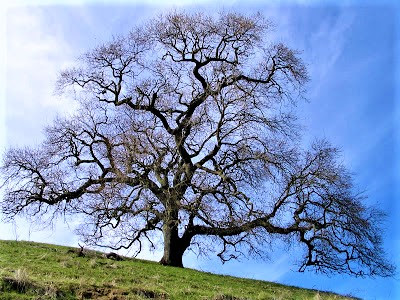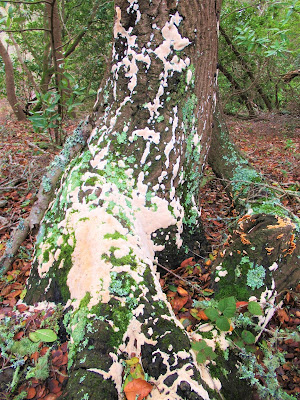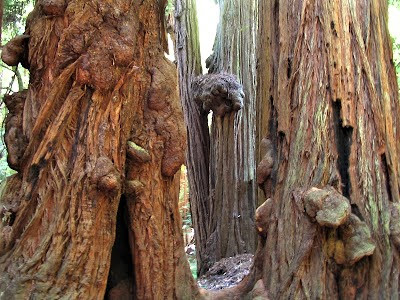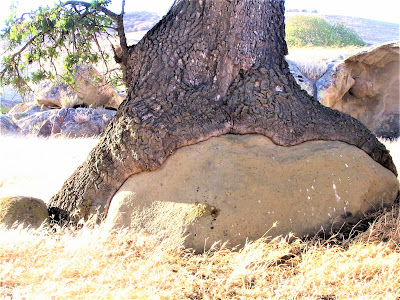BAY AREA ARBOREAL WONDERS: Magical Encounters / Spiritual Appointments with Our Beloved Old Acquaintances
"I frequently tramped eight or ten miles through the deepest snow to keep an appointment with a beech tree, or a yellow birch, or an old acquaintance among the pines."
– Henry David Thoreau

What nature lover worth their salt doesn't count a friend, many friends, in fact, among the great and small trees found in the forests, backyards and parks of the Bay Area.

Whether a sweet-scented Brugmansia in your back yard; a towering Redwood in Muir Woods; a magnificent Mama Madrone at Mount Diablo; a tentacled California Buckeye starkly exposed on a hillside ravine; or perhaps a stunted remnant Apple, Plum, Pear and Cherry trees from an old homesteader's orchard.

Or maybe you prefer arboreal romance with a monstrously twisted Oak on yonder ridge, it's always special, always a joyful encounter, and always worth tramping eight or ten miles (or just a few feet) to keep an appointment with our most familiar and cherished and beloved of arboreal acquaintances.

No need for gushing homilies or epiphanies in praise of the Planet Earth's most important biological beings; heck with ineffable words of pomp and bluster; who needs rhapsodic paeans to the plant kingdom's crown jewel of creation.

To get the picture, simply take a long leisurely look at the sylvan gallery showcasing the diversity and splendor of trees found growing in the 9-county, 47-square mile, 9,000,000 strong Bay Area landscape.

Trees you've come to know and love, develop an emotional relationship with, harbor deep feelings for, and yearn for their company evermore when you relive magical encounters and keep spiritual appointments with our Old Acquaintances.

Bay Area tree lovers (Dendrophiles!) have long rejoiced in a blessed abundance of healthy forest amidst urban surroundings.

(Note: four years of extreme drought have threatened, weakened and hastened mortality for thousands of trees; in one instance, at Del Valle Regional Park, the District is removing 100 untenable Poplars and replacing them with drought-tolerant Oak.)
.jpg)
Still. From sea level to over 4,000 feet elevation, native trees and exotic species alike flourish in diverse environments contained within a sprawling metropolitan area of skyrises, shopping malls, business parks, dense neighborhoods, and industrial blight – not the sort of surroundings you'd expect to find surrounded by expansive green belt!

But. Flying over the north flank of 2571 ft. Mount Tamalpais in Marin County, pilot Barbara Rowell remarked to her famous photographer / mountain climber husband, Galen:

"This is incredible. It’s all unbroken forest down there. I’m seeing more continuous forest right here in the Bay Area than in all my flights over the national parks of Costa Rica."

(Tragically, both perished in a plane crash near Bishop CA in 2002.)

No hyperbole on Barbara's sober-minded observation. Bay Area Dendrophiles are indeed fortunate to have in our midst, at our recreational disposal, beautiful open spaces abutting our large cities, splendid nature preserves contiguous to urban sprawl, and coastal foothills and pristine shoreline on the ecotone of the wild and the civilized, protected for all time.

Not too surprising that the oldest, tallest, baddest ass trees in the world reside here. Or once resided here, in the case of wiped out stands of old growth Coast Redwood, Douglas Fir and bountiful Oak groves – trees once numerous in their established ranges.

Muir Woods National Monument, in Marin County, California, holds within its moist and ancient bosom the Bay Area's only remaining OG forest, where once reigned the very tallest of California's Redwoods.

Fortunately, much second and third gen OG Coast Redwood and Douglas Fir were spared the ax, thanks to early preservationist efforts on the part of forward-thinking people horrified by wanton 19th century massacres ("harvesting") of the most prized and ancient local giants.

(Not even the stumps of the Old Ones exist to attest to their once impressive embodiment, having been cut out and chopped into firewood for a growing – and very chill, you presume – East Bay populace.)

Today, in the Oakland Hills, at Redwood Regional Park, you can stand in the "fairy circles" of Titan Sentinels once spotted by confused navigators from sixteen miles out beyond the Golden Gate Strait. No doubt amazed and humbled by their presence; perish the thought or need at that time of cutting them down for utility and profit.

For buccaneers, privateers and military patrols, the tallest trees in the world stood as beacons of orientation, welcoming them gently into the great San Francisco Bay from the rough outer waters of the Golden Gate Strait.

Dendrophiles, count your hundreds of thousands of blessings for a myriad of species of trees dotting Bay Area open spaces and natural places. Trees glorious trees, sheltered in 65 East Bay Regional Park District designations.

Harbored in an astounding 51 State Park sites; thriving in 10 National Parks, including the world-famous Golden Gate National Recreation Area and Point Reyes National Seashore; and last but not least, providing shade, succor, bird habitat and eye candy in countless backyards and city and county parks.

Bay Area trees have it good today. That is, unless you happen to be a reviled Blue Gum Eucalyptus just trying to make a living in the East Bay Hills. Long a contentious "fire safety" issue, the Australian transplant is also the bane of ecologists for its bio-adaptive ability to change soil conditions to its benefit but to the detriment of native flora.

After the devastating Oakland Hills firestorm of 1991,neighborhood and environmental groups pressed for their removal, along with a few thousand other non-native fire-hazardous trees.

The divisive issue only recently has bloomed into public consciousness, especially since news and clamor of the campaign broke, spearheaded by various public agencies to partner up with a master plan to cut 'em all down, root 'em all out.

Not to be accomplished without the herbicide Garlon 4 and Garlon 3A, of course, whose judicious applications (quote unquote) will introduce into the environment over the next ten years untold amounts of toxic Monsanto Roundup.

No matter how you apply it, poisonous chemicals will leech into the immediate biosphere for half a generation.

According to the Claremont Canyon Conservancy website, the herbicides:
.jpg)
" . . . will be used in such small quantities and under such strict controls that it will not be a carcinogen."

What would Rachel Carson say?

What would founding board member Marilyn Goldhaber say?

She admonishes:

" . . . being afraid of the herbicide is not a reasonable point of view.”

What would the Sierra Club say?

Attested to the common good, the harvesting plan, we've been told, is backed by sober impact review / appraisal and solid scientific evidence and entails ridding East Bay ridges of the dreaded scourge of unwanted and so-called out-of-place Eucalypti.


Trees that, yes, are suffocating out native plants. Trees that, Jesus!, were meant to bring a huge profit for their importer and grower, Frank Havens, but the old boy made a colossal blunder in his choice of inferior (useless) species to propagate.

So much for obscure history, but it's left us with all these damn unwanted combustible trees!

What would YOU say?

No matter if it's the right approach or the best thing to do, Gambolin' Man will go out on a limb and proclaim the plan, while conceding scientific and public safety arguments, is an unabashed case of Might Makes Right, and an irrepressible urgency to spend a $5.6 million dollar FEMA windfall underwriting the clear-cutting Operation Nuke-alyptus.

One thing is for sure, though: the plan is not, repeat, is not, in the best interests of Owls, Red-tailed Hawks, Turkey Vultures, and many other birds and insects who nest, feed and shelter in the otherwise unwanted trees' dense canopy.

Oh, well, we're told – and must believe – for how can we dispute scientific evidence? – that the benefits of Blue Gum eradication far outweigh any and all harm – end of argument!

But who speaks for the Owls, Red-tails, and many other birds and insects? Surely, they won't be poisoned, will they? Surely, they will successfully relocate elsewhere, won't they?

What would Leonardo DiCaprio say?

Back to the rich forests of the Bay Area – harboring a trove of native and exotic trees:

Pine. Spruce. Cedar. Juniper. Redwood. Yew. Willow. Madrone. Manzanita. Walnut. Birch. Laurel. Bay. Holly. Maple. Cypress. Nutmeg. Sycamore. Alder. Poplar. Dogwood. Cottonwood.

Throw in a dozen species of Oak and voilà:
.jpg)
A DENDROPHILES' TREETOPIA!
.jpg)
Other species of woody plants too numerous to mention also thrive in our local city parks, open spaces, wild places, residential landscaping, backyards, unincorporated areas, and along roadsides. In short, wherever a tree can find purchase.

Outside of tundra and extreme desert conditions, very few places are inhospitable to trees – the planet's preeminent manifestation of life's tenacious spirit, surely evolution's crowning natural achievement with tiny seedlings taking root in the most unlikely of places, surviving in the harshest of climes.


Think of a hardy stand of Palmer Oak ruling atop a distant ridge at Vasco Caves Regional Preserve, representing the tree's northernmost range, an uncommon desert species of Quercus known for its large acorns and Holly-like spiny leaves and generally found at altitudes a couple of thousand feet higher than Vasco Caves.

Yet here they exist, in splendid isolation on that high, distant ridge.

Think of specially adapted species eking out successful survival strategies in nutrient-depleted serpentine soils. Marvel at the stunted "genetically pure" strain (you believe) of Sargent's Cypress growing in rocky soil on Pine Mountain in Marin County.

Or, that wondrous lone Western Juniper rising out of a rocky crag above Donner Falls in Mount Diablo's Oat Canyon. Think Coulter and Grey ("Digger") Pine. normally found at higher foothill elevations but taking root and thriving in the perfect niche environments of Henry Coe and Mount Diablo State Parks.

Think Canyon Live and Black Oak found in dispersed, selective habitats, knotted, ancient gnarly assed species, draped in spooky strands of pale green moss, co-existing with parasitic Oak apple gall and other epiphytic entities that could easily compromise their being.

You have your favorite trees, the ones that when you come upon them during your nature outings, you recognize them as dear old friends. You bow down reverentially to them as living monuments.

You hug and kiss them shamelessly, and smell them lustily, and commune silently with them – in a mostly futile endeavor to mind meld with their undetectable y-wave penetrations carrying tantalizing hints to their mysterious existence.

Yeah, plenty to think about.

. . . the divine nature of trees . . .

. . . the heavenly trees of nature . . .

Certainly, you've learned through repeated osmotic sensations, that being in the company of trees, connecting physically / psychically with them, is the best therapy you can give yourself (next to water flowing).

Who else listens so well?

Who never talks back?

Who does not stand in judgment, nor fall to the ground in resentment, whether felled by the logger's ax or a bolt of lightning from the heavens.

Who just stands there, existing in a timeless state of transcendent patience and infinite but unseen forbearance.

For trees, you have come to know and appreciate, have a supernal ability to infuse your spirit with calm and peace, and pervade your senses with joy and love! Truly, trees are holy, something "only God can make" as you smile and nod at the reference to Joyce Kilmer's famous poem.


And now, enjoy a few of Gambolin' Man's favorite tree profiles:

Morgan Territory Explorations

Growing in a proto forest, right off the trail, is an enormous Manzanita, the most impressive Arctostaphylos you’ve ever seen, maybe residing in this sanctuary like a guardian of the ages for the past 300 years. Who knows.

Nearby Manzanitas deign to compete in girth, height, textural richness and sculptural complexity, but fall short of measuring up to this old dog.

It is truly an epic specimen showing off dark red chocolate skin tones the color of ancient Mayan cinnabar, a thick bodied, gnarled-branched piece of work. You circle it repeatedly, touching and stroking it, lost in rapt admiration, more even than you would for a prized sculptural masterpiece in the Louvre – if you were able to touch it.

Ohlone Wilderness Hike


There is sanctity and purity about this tree. You spend an inordinate amount of time admiring it, wondering about it, inspecting its various oddities, scrutinizing its subtle profundities, fascinated with lichen and moss growth and dozens of acorns cached in the deep grooves.

Muir Woods Cathedral of Trees


Somewhere along Redwood Creek is a tree over 250 ft. tall, 14 ft. wide, and 1000 years young. It sprouted around the time Vikings set sail for Vinland, when Toltecs ruled central Mexico, as Europe was emerging from the Dark Ages. It has outlived forty generations of humans.

It has survived fire, wind, storm, the ax.

Today, it is just middle-aged.

Will it be alive a thousand years from now, in the year 3000?

Will we paltry humans still be around to bear witness?

Vasco Caves Miracles

Same thing goes for the big Cottonwoods and the 100+ year old Valley and Interior Live Oak, thirsty trees which require year-round access to water. In a geological conundrum, the preserve is a subtle water-dependent ecosystem where plants thrive in harsh conditions owing to ground water that is forced to the surface from far away by complex subterranean activities that somehow push it to this area.

Arboreal Wonders of California


The Sacred Acorn was the foundation of their subsistence patterns, the raison d’etre of their celebratory rituals; indeed, the powerhouse nut represented the key to life itself and the marking of new phases of time.

It’s easy to see why the mighty Oak – Emerson's “the creation of a thousand forests in one acorn” – was so revered by native tribal peoples in North America and ancients the world over.

Wherever this ubiquitous keystone species is found, it has always provided an important dietary staple for humans, Oak groves create drought-tolerant islands of shade and coolness, and spawn environments conducive to a rich wildlife habitat.
.jpg)
In California alone, Oak forests sustain over 100 species of birds, while multiple dozens of its land mammals rely on Oak in some symbiotic relationship during their lifetime.
.jpg)
Original Jurassic Park – Oakland's Giant Redwoods

Make no mistake – this ain't wilderness, but it was once primal forest where grizzlies, mountain lions, condors and bald eagles prowled the ridges and patrolled the skies. Before the saw mills of the 1860s wiped them out, this locale supported the largest, tallest and most magnificent Sequoia sempervirens on Earth.

Malcolm Margolin describes today’s present crop of offspring as:

" . . . a race of adolescent giants rising out of logged off remains . . .With their great size and a botanic history that stretches back 100 million years to the Age of Reptiles, the Redwoods . . . seem aloof from the modern world."
.jpg)
Indeed, they are, and so are you when standing in their midst, lost and mindless to civilization’s buzzing, humming, whirring and mechanized noises down on the flats.

Check out Gambolin' Man's paean to the divine nature of trees:

Check out Gambolin' Man's extensive photo gallery with over 3,000 images:

WOODMAN, SPARE THAT TREE
(By George Pope Morris, 1837)
.jpg)

3 Comments:
Fun blog, Tom. When I was in Australia, a driver talked about the Eucalyptus fueling fires. Apparently those trees aren't popular there either. :)
What a treasure this blog page is; fabulous images and lovingly crafted accompanying text. Tomfoolery is a treemendous talent, and generous spirit who makes life better for us, the trees, and the birds that dwell therein!
Fantastic entry here amigo mio!!! -- MG
Post a Comment
<< Home